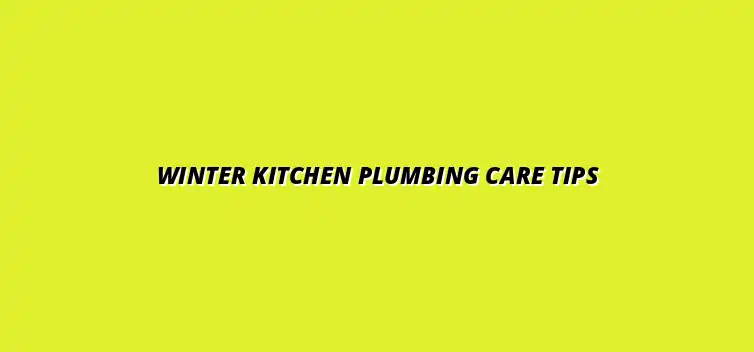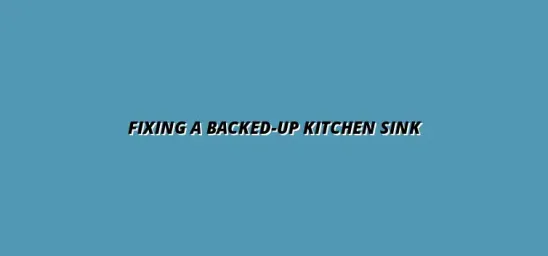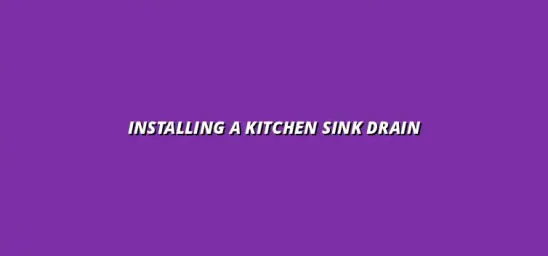
Winter Kitchen Plumbing Care Tips
Understanding the Importance of Kitchen Plumbing Care in Winter
When winter arrives, many homeowners overlook the importance of kitchen plumbing care. Cold temperatures can significantly affect your plumbing systems, leading to potential issues that could cause inconvenience and damage. It's crucial to understand how winter impacts plumbing so you can take the necessary steps to protect your kitchen. For helpful tips on winter plumbing preparation, check out this guide on winter plumbing preparation tips.
Not only does cold weather affect the water flow, but it can also threaten the integrity of your pipes and fixtures. By being aware of these challenges, you can proactively secure your plumbing against the chill. After all, a little awareness can save you a lot of trouble down the road!
The Impact of Cold Weather on Kitchen Plumbing Systems
Cold weather can be brutal on your kitchen plumbing systems. When temperatures drop, the water inside pipes can freeze, leading to a series of unfortunate events. Understanding how freezing temperatures impact your plumbing is the first step toward preventing costly repairs!
Here’s what you need to know about how the cold affects your plumbing:
- Water expands as it freezes, putting pressure on pipes.
- Frozen water can block the flow, causing damage to fixtures.
- Extreme cold can lead to complete pipe bursts.
How Freezing Temperatures Affect Pipes and Fixtures
When temperatures plummet, pipes made of metal or plastic are at risk of freezing. This is especially true for pipes located in unheated areas, such as under sinks or in exterior walls. When water freezes, it expands and can cause the pipes to crack or burst.
Additionally, fixtures like faucets and appliances can also be affected. A frozen faucet can lead to leaks once thawed, creating water damage in your kitchen. Regular checks during winter can help catch these issues before they become major problems! Learn more about preventing your water heater from freezing with these preventative measures.
The Risks of Frozen and Burst Pipes in Your Kitchen
The risks of frozen and burst pipes are significant! A burst pipe can lead to extensive water damage, which may require costly repairs and even mold remediation. It can also disrupt your daily activities, leaving you without water when you need it most.
Here are some risks associated with frozen pipes:
- Flooding in your kitchen.
- Damage to walls and floors due to water exposure.
- Potential health hazards from mold growth.
Proactive Steps for Preventing Plumbing Issues in Winter
Taking proactive steps is key to avoiding plumbing issues during the winter months. By preparing your kitchen plumbing ahead of time, you can ensure that everything runs smoothly, no matter how cold it gets outside. Let's go over some essential measures you can implement! For example, these winter plumbing tips can help prevent freezing.
From insulating pipes to maintaining a consistent temperature, these actions can help keep your kitchen plumbing safe and functional. Remember, a little preparation goes a long way in ensuring peace of mind during the chilly season!
Insulating Pipes to Combat the Cold
Insulation is an effective way to protect your pipes against freezing. By covering your pipes with insulation material, you can help them retain heat and stay warm during cold weather. This simple yet effective step can save you a lot of hassle and money!
If you're unsure how to insulate your pipes, consider the following materials:
- Foam pipe insulation: Easy to install and highly effective.
- Heat tape: Provides additional warmth to keep pipes from freezing.
- Blankets or towels: Can be used in a pinch for temporary insulation.
Materials and Methods for Effective Pipe Insulation
Choosing the right materials for pipe insulation is crucial. Each option has its own benefits, and understanding these can help you make the best decision for your kitchen. Using foam insulation is popular because it's lightweight, inexpensive, and provides excellent thermal resistance!
Some methods for applying insulation include:
- Wrapping foam around pipes and securing with tape.
- Applying heat tape along the length of vulnerable pipes.
- Using pre-slit pipe insulation for easy application.
Identifying Vulnerable Areas in Your Kitchen Plumbing
It's essential to know which areas in your kitchen are most vulnerable to freezing. Common trouble spots include pipes running along exterior walls and those located in unheated spaces like cabinets. By identifying these areas, you can focus your insulation efforts where they matter most! Regular maintenance is key, and you can find essential kitchen plumbing maintenance tips here.
To find vulnerable areas, consider these steps:
- Inspect areas near windows and doors for drafts.
- Check under sinks and in crawl spaces for exposed pipes.
- Look for plumbing that runs along exterior walls.
Addressing Common Kitchen Plumbing Questions in Winter
When the winter chill sets in, many homeowners become concerned about their kitchen plumbing. It’s crucial to be aware of the common questions that arise during this season. Addressing these concerns can save you time, money, and stress! Let’s dive into some of the most frequent kitchen plumbing questions that people have when the temperature drops.
What Are the Signs of Frozen Pipes?
Detecting frozen pipes early can help prevent serious damage. There are several key indicators to watch for in your kitchen that signal your pipes may be freezing. These signs can vary, but being aware can make a big difference!
- No water flow: If you turn on the faucet and nothing comes out, it may be a sign of frozen pipes.
- Unusual sounds: Listen for strange noises when you try to run water; it might indicate pressure build-up.
- Cold spots: Check your pipes for areas that feel noticeably colder than others.
- Visible frost: If you see frost on the outside of your pipes, they are likely frozen.
Key Indicators to Watch For in Your Kitchen
Spotting potential problems early can keep your kitchen's plumbing system running smoothly. If you have a clogged kitchen sink, learning how to fix a clogged kitchen sink is important.
- Ice formation: Look for ice around pipe fittings.
- Leaking pipes: If pipes have burst, you may notice leaks or water stains.
- Slow draining: A slow drain can suggest a blockage caused by ice.
How to Differentiate Between Frozen and Clogged Pipes
Understanding whether you have frozen pipes or a clog is essential for effective troubleshooting. Here are some differences to help you identify the issue:
- Temperature: Frozen pipes will be cold to the touch; clogged pipes may not be.
- Location: Frozen pipes are often found in unheated areas, while clogs can occur anywhere.
- Water flow: With frozen pipes, there is a complete halt in flow; clogs may allow some water to pass.
Can I Use Hot Water to Thaw Frozen Pipes?
When faced with frozen pipes, many wonder if using hot water is a viable option to thaw them. While it may seem like a quick fix, there are pros and cons to consider before jumping in!
Pros and Cons of Using Hot Water for Thawing
Using hot water on frozen pipes can have mixed results. Here are some advantages and disadvantages to think about:
- Pros:
- Quick thawing of the affected area.
- May relieve pressure in the pipes.
- Cons:
- Risk of pipe damage if the water is too hot.
- Could cause further ice blockage downstream.
Alternative Methods for Thawing Without Damage
If hot water isn’t the best option for thawing your pipes, there are safer alternative methods you can try. Preventing grease buildup in your kitchen drain can also help avoid plumbing issues. Here are some tips to prevent grease buildup.
- Hairdryer: Use a hairdryer on low heat to gently warm the pipes.
- Heating pads: Wrap frozen pipes with heating pads or towels soaked in warm water.
- Space heaters: Set up a space heater in the area where pipes are frozen, ensuring it is safe and monitored.
Final Thoughts on Winter Kitchen Plumbing Maintenance
Taking care of your kitchen plumbing during the winter months can help you avoid emergencies. By understanding common questions and implementing proactive measures, you can keep your plumbing running smoothly. Let’s explore how to create a seasonal maintenance checklist to ensure everything is in order!
Creating a Seasonal Maintenance Checklist for Kitchen Plumbing
A maintenance checklist can be a helpful tool to keep track of tasks needed to protect your plumbing during winter. Here are some essential tasks to include in your winter preparation:
- Inspect pipes: Look for signs of wear or vulnerability.
- Insulate exposed pipes: Use insulation kits or materials to protect vulnerable pipes.
- Check for leaks: Look for leaks in visible pipes and fixtures.
- Test faucets: Ensure all faucets are functioning properly.
Essential Tasks to Include in Your Winter Preparation
To further enhance your winter plumbing care, consider these additional tasks:
- Know your shut-off valves: Ensure you know where your main shut-off valve is located.
- Clean gutters: Clear debris from gutters to prevent ice damming.
- Open cabinet doors: Allow warm air to circulate around plumbing under sinks.
Resources for Finding Professional Plumbing Services
If you feel overwhelmed or notice severe plumbing issues, don't hesitate to reach out for help! For example, if you need a plumber in Deritend, Birmingham, you can find one here. Here are some resources to find professional plumbing services:
- Online directories: Websites like Yelp or Angie's List can help you find local plumbers.
- Word of mouth: Ask friends or neighbors for recommendations.
- Home Improvement Stores: Staff at local hardware stores often have plumber contacts.
Encouraging Proactive Care to Avoid Emergency Situations
Emphasizing proactive plumbing care is key to preventing emergencies. Regular maintenance can save you time, money, and stress during the winter months!
Long-term Benefits of Regular Maintenance for Your Kitchen Plumbing
Investing time in regular plumbing maintenance provides various long-term benefits:
- Increased longevity: Well-maintained pipes last longer.
- Reduced costs: Preventative care can minimize costly repairs.
- Peace of mind: Knowing your plumbing is in good shape reduces stress.
Empowering Homeowners with Knowledge for Winter Plumbing Care
Knowledge is power! By understanding your plumbing and how to care for it, you empower yourself to tackle winter challenges confidently. Remember, proactive care can lead to a stress-free winter season in your kitchen!





Fixing a Backed-Up Kitchen Sink
Prepare Your Plumbing for Weather
Installing a Kitchen Sink Drain
When to Replace Plumbing Fixtures
Fixing a Jammed Garbage Disposal